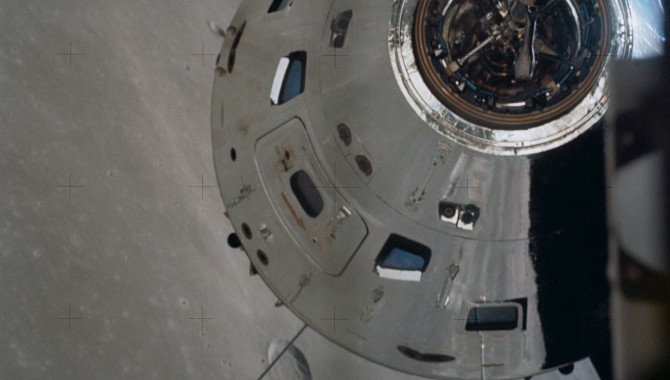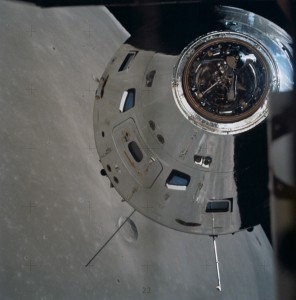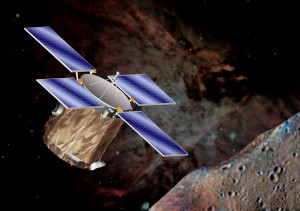
By Howard E. McCurdy
The first phase of the Vision for Space Exploration—wherein humans and their machines return to the Moon—is no exception. NASA officials could dust off old blueprints and return to the Moon using 1960s technology. That path is well known. Yet any attempt to repeat the lunar landings using Apollo techniques would degrade one of the primary objectives of the return–the desire to develop technologies that eventually will carry humans beyond the Earth–Moon system toward Mars.

The surface of the Moon is reflected in the command and service module in this December 1972 image from the Apollo 17 mission. NASA’s Vision for Space Exploration will use a new spaceship that builds on the best of Apollo and shuttle technology.
Image Credit: NASA
Of these potential innovations, few are more important than those affecting cost. When quizzed on the affordability of the Vision for Space Exploration during its consideration in 2003, NASA officials assured White House aides that a return to the Moon could be accomplished using Apollo-style technology for less than the cost of landing the first humans on the Moon in 1969. NASA officials pointed out that they would not need to incur the expense of constructing the Johnson or Kennedy space centers or a new tracking network. They would not need to charge the cost of excess equipment used for future missions against the first, as Apollo program managers had done. By using tested technologies, they could save money on the crew exploration vehicle, the lander, and a new launch vehicle. The total savings, NASA officials estimated in 2003, would amount to about half of the inflation-adjusted $147 billion spent to send the first humans to the Moon. The estimated savings have varied from study to study, and recently shrunk, but the underlying principle remains the same. Using Apollo-style technology, the United States can return to the Moon for a sum that fits within projected NASA budgets. It will not be easy, but it can be done.
Now take that analysis one step further. Suppose the United States, with its international partners, attempts to use Apollo techniques to send humans to Mars. In other words, the expedition uses chemical-fueled rockets, small capsule-shaped spacecraft, a Martian orbit rendezvous, a mission length of 900 days, and Apollo-style project management in which every element of the mission and its possible interactions are triple-checked before the first astronauts leave. The cost of a mission of such complexity rapidly approaches $1 trillion. Could the United States afford to organize such an expedition? Yes, it could. Is Congress likely to provide the necessary funds? No. In short, any attempt to return to the Moon using Apollo-style techniques is likely to defeat the ultimate purpose of the undertaking, making the next Moon landing an end in itself rather than a means to a more spectacular objective.
What can NASA officials do to resolve this conundrum? As a first step, they can seek inspiration from the people who organized Project Apollo. When President John F. Kennedy challenged Americans to race to the Moon in May 1961, no one in NASA knew how to do it. NASA engineers had not yet invented lunar-orbit rendezvous. Wernher von Braun’s rocket team had not yet perfected the hydrogen-burning J-2 engines that would propel the Saturn V rocket’s second stage. NASA officials had yet to embrace consolidated or “all-up” testing, one of the practices that allowed the space agency to meet its end-of-the-decade deadline. More significantly, few people in NASA knew how to organize projects as big as Apollo. NASA scientists and engineers had plenty of technical capability, lots of hands-on skill, and plenty of experience with small projects. People in the newly created space agency had practically no experience, however, managing an undertaking as interactive and complex as Project Apollo.
To resolve the management challenge, NASA Administrator James Webb looked outside the Agency. He turned to the U.S. Air Force and its supporting contractors, where people working on the crash program to deploy a fleet of intercontinental ballistic missiles (ICBMs) had spent the previous decade developing a technique called large-scale systems management. Webb recruited people like George Mueller and General Sam Phillips from the air force ICBM program to help reorganize NASA. They introduced techniques like configuration control, concurrent development, progressive design freezes, and systems integration studies to produce an agency organizationally capable of reaching the Moon. Historian Stephen Johnson has called these techniques “the secret of Apollo.” Without large-scale systems management, the lunar landings would not have occurred�certainly not with the degree of reliability that the United States achieved.
So where can NASA officials turn for the next round of innovations, in particular for the low-cost innovations necessary to take humans beyond the Moon? To start, they can look within their own organization. This may seem like a strange suggestion for an agency that has struggled for thirty years to meet cost and schedule goals on the Space Shuttle and International Space Station. Yet NASA program managers have accumulated many years of experience with low-cost innovation, including experience from projects that worked (like Mars Pathfinder and NEAR-Shoemaker) and ones that failed (like Mars Climate Orbiter and CONTOUR).
The techniques used to manage a succession of “faster, better, cheaper” projects during the past fifteen years may not scale up well to projects as complicated as human expeditions to the Moon, but they contain valuable lessons nonetheless. One profound lesson is the importance of centers of integration. The low-cost projects that worked best possessed focused centers of integration in which the same team of technically competent people designed, built, and flew the spacecraft. Team leaders used contractors to build spacecraft components, but the teams did not distribute their core functions. Low-cost projects that got in trouble invariably did, with results like those afflicting Mars Climate Orbiter, with one team working with English units of measurement and another using metrics.

NEAR-Shoemaker approaches asteroid Eros in this artist’s concept. NEAR is one of many successful projects that helped program managers gain experience in low-cost innovation.
Photo Credit: NASA/John Hopkins University Applied Physics Laboratory
A preference for work packages and extensive contracting characterizes NASA’s preferred approach for large-scale project management. It worked well for Project Apollo, accompanied as that was by a strong center of systems integration and plenty of in-house technical capability. Yet the approach is very expensive, prohibitively so when one considers it as a method for sending humans to Mars. To get to the Moon and beyond on a budget, NASA officials might consider reestablishing single centers of systems integration with very strong technical capabilities. It would be nice if those centers were inside the Agency, but they could be outside as well so long as they are concentrated and technically strong.
Next, NASA officials can look beyond the Agency to innovations taking place in the private sector and elsewhere in government. The aerospace contractors on whom NASA project managers have traditionally relied are not a good source in this regard. They exist in a business environment that provides few incentives for cost innovation. The reverse is true in the highly competitive electronics and information sectors, where firms face incredible pressures to innovate or perish. Backed by entrepreneurs from these sectors, innovators like Burt Rutan are seeking new and economical ways to accomplish the first steps in space that NASA officials took forty-five years ago. The management techniques and technologies they use are often radically different from the ones NASA pioneered.
Government leaders insist that the new vision for space exploration will be carried out by humans and robots exploring space together. Some of the most innovative work in this regard is taking place in the U.S. Department of Defense, especially the Defense Advanced Research Projects Agency (DARPA). The defense department is working to reengineer one-third of its transport vehicles so they can be driven by robots by 2015. One of the lessons to be gathered from this activity is the importance of prizes. DARPA officials have used contests such as the 132-mile Grand Challenge for robot vehicles across the Mojave Desert to encourage innovation in pursuit of this goal.
Finally, NASA can learn from its international partners and competitors, especially Russia and China. Both nations conduct space programs at a fraction of the NASA enterprise expense. They accomplish less, but what they do produce (like the Soyuz launch system) costs far less than U.S. counterparts. The difference cannot be explained entirely by lower labor costs. The adoption of production line methods may account for a significant portion of the cost reductions achieved on the Russian vehicles.
So where can NASA officials turn for the next round of innovations, in particular for the low-cost innovations necessary to take humans beyond the moon? To start, they can look within their own organization.
When President Kennedy assigned NASA the task of sending humans to the Moon in the spring of 1961, agency officials were not capable of doing the job. Yet eight years later Americans stood on lunar soil. Through two major reorganizations and frequent innovations, NASA founders transformed their young agency. Most of the transformations were painful; many were controversial. The desire of NASA officials to achieve their goal outweighed their pain. The NASA that dispatched Americans to the surface of the Moon in the summer of 1969 little resembled the organization that started the journey eight years earlier.
In a similar fashion, if NASA employees and their contractors succeed in returning humans to the Moon and dispatching them and their machine companions to Mars, the organization that completes the work will bear little resemblance to the one that exists today. Innovation will occur again. The NASA that completes the new challenge will be as transformed as the NASA of 1969 was relative to itself in 1961.







